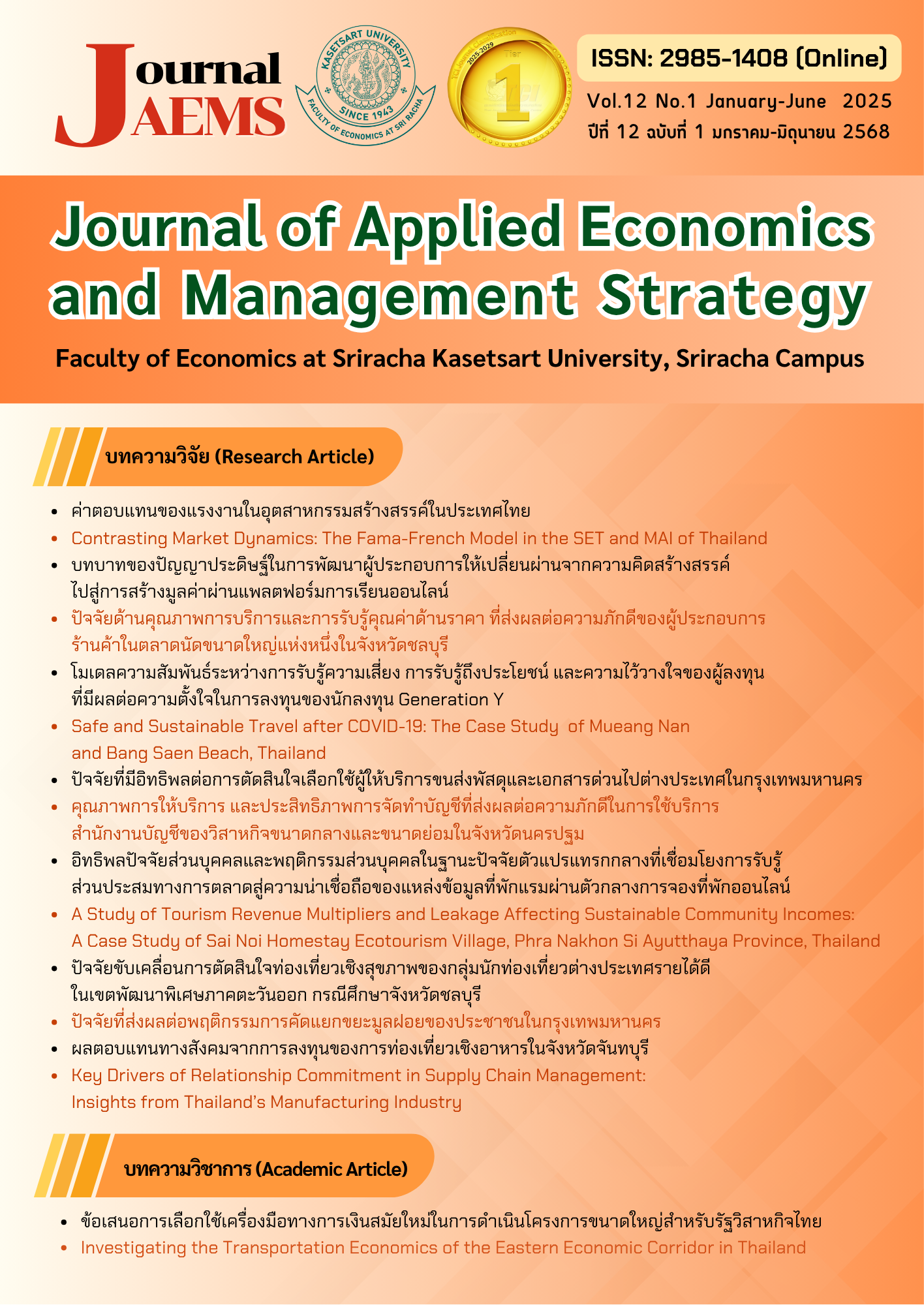Compensation of Workers in the Creative Industries in Thailand
Main Article Content
Abstract
This research aimed to study compensation of workers in the creative industries in Thailand. This research used demographic-related data collected from the National Statistical Office (NSO) in the Labor Force Survey from 2012–2022, totaling 11 years with 10,711 observations. Descriptive statistics and regression analysis were used to describe the characteristics of labor compensation in the creative industry. The majority of creative industry workers (98 percent) were private employees, worked in the Creative Originals group, lived in the municipal area, had a primary education level, were married and were female. In the part of studying the factors related to labor compensation in the creative industry, this study applied Mincer's (1974) wage model It was found that factors that affect labor compensation in creative industries in Thailand were gender, marital status, household head status, educational level, work experience, minimum wage rate, provincial GDP per capita, provincial consumer price index, and urbanization. In addition, it was found that only those working in the Creative Goods/Products, Creative Content/Media, and Creative Originals groups had average labor compensation that is 6.3 percent, 5.1 percent, and 2 percent higher than those working in other creative group, respectively. By investing in education, developing the skills necessary for workers in the creative industries was also essential for the country's economic development.
Downloads
Article Details

This work is licensed under a Creative Commons Attribution-NonCommercial-NoDerivatives 4.0 International License.
References
กระทรวงพาณิชย์. (2567ก). ข้อมูลดัชนีราคาผู้บริโภคของกรุงเทพมหานคร. สืบค้นจาก http://www.indexpr.moc.go.th/price_present/cpi/stat/others/indexg_report2.asp?list_year=2550
กระทรวงพาณิชย์. (2567ข). ข้อมูลดัชนีราคาผู้บริโภคระดับจังหวัด. สืบค้นจาก https://www.price.moc.go.th/price/cpi_province/index_new.asp
กระทรวงแรงงาน.(2567). ข้อมูลค่าจ้างขั้นต่ำรายจังหวัด. สืบค้นจาก https://www.mol.go.th/en/minimum-wage
สํานักงานสภาพัฒนาการเศรษฐกิจและสังคมแห่งชาติ. (2565). ผลิตภัณฑ์ภาคและจังหวัด. สืบค้นจาก https://www.nesdc.go.th/main.php?filename=gross_regional
สำนักงานส่งเสริมเศรษฐกิจสร้างสรรค์. (2566). มูลค่าของเศรษฐกิจสร้างสรรค์. สืบค้นจาก https://data.cea.or.th/
สำนักงานสถิติแห่งชาติ. (2566). ข้อมูลประชากร และข้อมูลผลิตภัณฑ์จังหวัด. สืบค้นจาก https://data.go.th/dataset/dataset_13_017
Been, W., & Keune, M. (2020). That is just part of being able to do my cool job: Understanding low earnings but high job satisfaction in the creative industries in the Netherlands. In V. Pulignano, & F. Hendrickx (Eds.), Employment Relations in the 21st Century: Challenges for Theory and Research in a Changing World of Work (pp. 59–76). (Bulletin of Comparative Labour Relations; Vol. 107). Wolters Kluwer.
Been, W., Wijngaarden, Y., & Loots, E. (2023). Welcome to the inner circle? Earnings and inequality in the creative industries. Cultural Trends, 33(3), 255-271. https://doi.org/10.1080/09548963.2023.2181057
Blaug, M. (1976). The rate of return on investment in education in Thailand. The Journal of Development Studies, 12(2), 270–283. https://doi.org/10.1080/00220387608421572
Lewis, P., & Lee, J. Y. (2020). The labour market outcomes of Australian Creative Arts degree holders. Australian Journal of Labour Economics, 23(1), 21–42. https://search.informit.org/doi/10.3316/informit.315586652826585
Moenjak, T., & Worswick, C. (2003). Vocational education in Thailand: a study of choice and returns. Economics of Education Review, 22(1), 99–107. https://doi.org/10.1016/S02727757(01)00059-0
Prediger, D. J., & Hanson, G. R. (1976). Holland’s theory of careers applied to women and men: Analysis of implicit assumptions. Journal of Vocational Behavior, 8(2), 167–184. https://doi.org/10.1016/0001-8791(76)90019-1
Psacharopoulos, G. (1994). Returns to investment in education: A global update. World Development, 22(9), 1325–1343. https://doi.org/10.1016/0305-750X(94)90007-8
Tangtipongkul, K. (2015). Rates of return to schooling in Thailand. Asian Development Review, 32(2), 38–64. https://doi.org/10.1162/ADEV_a_00051
Throsby, D. (2008). The concentric circles model of the cultural industries. Cultural Trends, 17(3), 147–164. https://doi.org/10.1080/09548960802361951
Warunsiri, S., & McNown, R. (2010). The returns to education in Thailand: A pseudo-panel approach. World Development, 38(11), 1616–1625. https://doi.org/10.1016/j.worlddev.2010.03.002
Zawadzki, K., & Wojdyło, M. (2018). Creative workers: returns to education and experience. The evidence from Australia. Economic and Environmental Studies, 18(2), 1017–1033. http://cejsh.icm.edu.pl/cejsh/element/bwmeta1.element.desklight-eedf188e-d1aa-4221-8cc2-b44578066f3c
